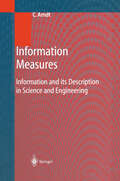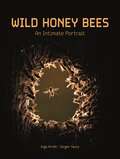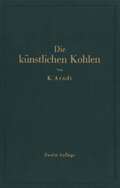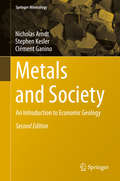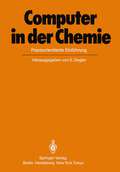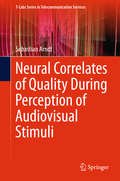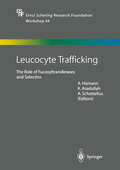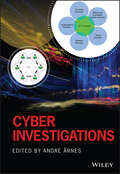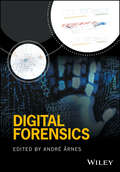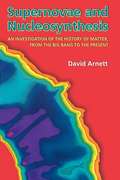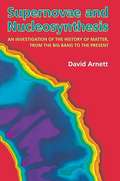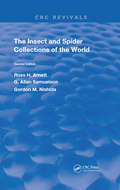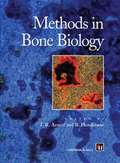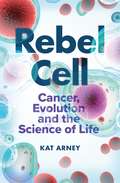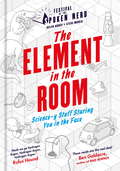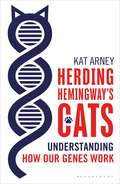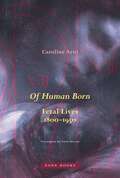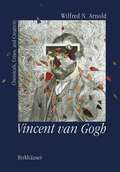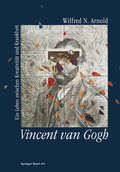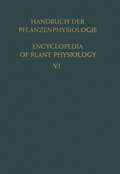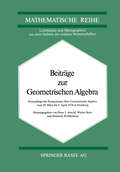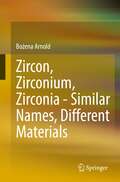- Table View
- List View
Information Measures: Information and its Description in Science and Engineering (Signals and Communication Technology)
by Christoph ArndtFrom the reviews: "Bioinformaticians are facing the challenge of how to handle immense amounts of raw data, […] and render them accessible to scientists working on a wide variety of problems. [This book] can be such a tool." IEEE Engineering in Medicine and Biology
Wild Honey Bees: An Intimate Portrait
by Ingo Arndt Jürgen TautzA lavishly illustrated exploration of the mysterious, hidden world of forest-dwelling wild honey bees—with new insights that promise to revolutionize conservation and beekeepingThe honey bee, a key pollinator, is now an endangered species, threatened by human activity and loss of biodiversity. Because of this, understanding forest-dwelling wild honey bees—which are more resistant to diseases and parasites than honey bees kept by beekeepers—is more important than ever before. In this lavishly illustrated book, Ingo Arndt, one of the world’s best wildlife photographers, and Jürgen Tautz, one of the world’s leading bee experts, set out on the trail of wild honey bees, bringing back sensational photographs, some of which document behaviors never captured before, and new scientific insights that promise to revolutionize conservation and beekeeping.A remarkable number of wild honey bee colonies still exist, living in hollow trees inside the forest, largely unnoticed by humans. This book explores the fascinating secret world of wild honey bees, including the adaptations and behaviors they have acquired to survive and the new challenges they face today. Featuring incredible macro and wide-angle photographs, some taken from inside hives, Wild Honey Bees is a unique collaboration that documents a major research project and offers critical new insights about these essential creatures.A stunning photographic record that documents for the first time the original way of life of the endangered, forest-dwelling honey beeA unique collaboration between one of the world’s best wildlife photographers and one of its leading bee expertsFeatures incredible macro and wide-angle photographs, some from inside the hive, depicting bees as never seen beforeOffers fascinating new insights into the mysterious, hidden world of the wild honey bee
Wild Honey Bees: An Intimate Portrait
by Ingo Arndt Jürgen TautzA lavishly illustrated exploration of the mysterious, hidden world of forest-dwelling wild honey bees—with new insights that promise to revolutionize conservation and beekeepingThe honey bee, a key pollinator, is now an endangered species, threatened by human activity and loss of biodiversity. Because of this, understanding forest-dwelling wild honey bees—which are more resistant to diseases and parasites than honey bees kept by beekeepers—is more important than ever before. In this lavishly illustrated book, Ingo Arndt, one of the world’s best wildlife photographers, and Jürgen Tautz, one of the world’s leading bee experts, set out on the trail of wild honey bees, bringing back sensational photographs, some of which document behaviors never captured before, and new scientific insights that promise to revolutionize conservation and beekeeping.A remarkable number of wild honey bee colonies still exist, living in hollow trees inside the forest, largely unnoticed by humans. This book explores the fascinating secret world of wild honey bees, including the adaptations and behaviors they have acquired to survive and the new challenges they face today. Featuring incredible macro and wide-angle photographs, some taken from inside hives, Wild Honey Bees is a unique collaboration that documents a major research project and offers critical new insights about these essential creatures.A stunning photographic record that documents for the first time the original way of life of the endangered, forest-dwelling honey beeA unique collaboration between one of the world’s best wildlife photographers and one of its leading bee expertsFeatures incredible macro and wide-angle photographs, some from inside the hive, depicting bees as never seen beforeOffers fascinating new insights into the mysterious, hidden world of the wild honey bee
Die künstlichen Kohlen für elektrische Öfen, Elektrolyse und Elektrotechnik
by Kurt Arndt J. ZellnerDieser Buchtitel ist Teil des Digitalisierungsprojekts Springer Book Archives mit Publikationen, die seit den Anfängen des Verlags von 1842 erschienen sind. Der Verlag stellt mit diesem Archiv Quellen für die historische wie auch die disziplingeschichtliche Forschung zur Verfügung, die jeweils im historischen Kontext betrachtet werden müssen. Dieser Titel erschien in der Zeit vor 1945 und wird daher in seiner zeittypischen politisch-ideologischen Ausrichtung vom Verlag nicht beworben.
Metals and Society: An Introduction to Economic Geology (Springer Mineralogy #2)
by Nicholas Arndt Stephen Kesler Clément GaninoThis book is a comprehensive overview of economic geology for the general geologist and anyone else interested in the minerals industry and the global supply of raw materials. It includes some thought-provoking statements and questions for discussion on globalisation and current practices in the minerals industry. In the second edition, all chapters have been extensively revised, and a new author has been added to increase coverage of some mineral deposits and topics. The economic issues surrounding the exploitation of mineral resources is discussed in three of the six chapters of the book. It deals with issues that are commonly addressed in current science reporting – the rate of exploitation of natural resources, the question of when or if these resources will be exhausted, the pollution and social disturbance that accompanies mining, the compromises and challenges that arise from the explosion in demand from China, India and other rapidly developing countries, and the moral issues that surround mining of metals in lesser-developed countries for consumption in the “first-world” countries. The book will be useful both as an introductory text for students in the earth sciences and a reference volume for students, teachers and researchers of geography, economics and the social sciences.
Computer in der Chemie: Praxisorientierte Einführung
by R. W. Arndt P. Bischof J. T. Clerc J. Gasteiger C. Krüger G. Szekely K. Varmuza E. Zass E. Ziegler1907-66: 3'791'519 1967-71: 1'314'655 (8. Sammelregister) 6'418'796 1972-76: 1'772'194 (9. Sammelregister) { online 1977 -81: 2'201'680 (10. Sammelregister) 1982- : 1'130'267 (bis Bd. 100; 30. 6. 84) Seit 1965 hat CAS 6'699'392 verschiedene chemische Verbindungen registriert (Stand: 30. 6. 84); dazu kommen noch ca. 1,5 Mill. Verbindungen, die vor 1965 in der Literatur erschienen sind und z. Z. maschinell erfaßt werden [6]. Wie kann man nun diese Informationsmengen noch mit vertretbarem Auf wand bewältigen? Als etwa Mitte des letzten Jahrhunderts die Zahl der Zeit schriften so groß wurde, daß sie vom einzelnen Wissenschaftler nicht mehr überschaubar war, entstanden die ersten Referatezeitschriften [1 a, 7]. Heute reicht dieses Instrument der Information in seiner gedruckten, manuell zu be nutzenden Form nicht mehr aus. Die Verarbeitung und Speicherung von gro ßen Datenmengen mit Computern liegt auf der Hand [8]. Die heute wichtigste Einsatzform des Computers zur gezielten (Wieder)gewinnung von Information (,Retrieval') durch den (End)benutzer ist die ,Online-Recherche'.
Neural Correlates of Quality During Perception of Audiovisual Stimuli (T-Labs Series in Telecommunication Services)
by Sebastian ArndtThis book presents a new approach to examining the perceived quality of audiovisual sequences. It uses electroencephalography (EEG) to explain in detail how user quality judgments are formed within a test participant, and what the physiological implications might be when subjects are exposed to lower quality media. The book redefines the experimental paradigms of using EEG in the area of quality assessment so that they better suit the requirements of standard subjective quality testing, and presents experimental protocols and stimuli that have been adjusted accordingly.
Leucocyte Trafficking: The Role of Fucosyltransferases and Selectins (Ernst Schering Foundation Symposium Proceedings #44)
by ArndtSchottelius KhusruAsadullah AlfHamannAn essential component of inflammation is the migration of circulating leukocytes from blood into tissues. This process is characterized by a multistep paradigm of sequential cell adhesion and activation events that lead to the extravasation of specific leukocyte subsets to different tissues in health and disease. The first step of leukocyte extravasation, the rolling of leukocytes, is primarily mediated by the interactions of selectins and their ligands. It has recently become evident that fucosyltransferases are crucial for selectin ligand synthesis, inflammation, and skin homing. This book provides an in-depth overview of the mechanisms of leukocyte trafficking and of the molecular mechanisms of selectin/selectin ligand interactions and discusses options for pharmacological intervention to treat inflammatory diseases.
Cyber Investigations
by André ÅrnesCYBER INVESTIGATIONS A classroom tested introduction to cyber investigations with real-life examples included Cyber Investigations provides an introduction to the topic, an overview of the investigation process applied to cyber investigations, a review of legal aspects of cyber investigations, a review of Internet forensics and open-source intelligence, a research-based chapter on anonymization, and a deep-dive in to multimedia forensics. The content is structured in a consistent manner, with an emphasis on accessibility for students of computer science, information security, law enforcement, and military disciplines. To aid in reader comprehension and seamless assimilation of the material, real-life examples and student exercises are provided throughout, as well as an Educational Guide for both teachers and students. The material has been classroom-tested and is a perfect fit for most learning environments. Written by a highly experienced author team with backgrounds in law enforcement, academic research, and industry, sample topics covered in Cyber Investigations include: The cyber investigation process, including developing an integrated framework for cyber investigations and principles for the integrated cyber investigation process (ICIP) Cyber investigation law, including reasonable grounds to open a criminal cyber investigation and general conditions for privacy-invasive cyber investigation methods Perspectives of internet and cryptocurrency investigations, including examples like the proxy seller, the scammer, and the disgruntled employee Internet of things (IoT) investigations, including types of events leading to IoT investigations and new forensic challenges in the field Multimedia forensics facilitates the understanding of the role of multimedia in investigations, including how to leverage similarity matching, content-based tracing, and media metadata. Anonymization networks discusses how such networks work, and how they impact investigations? It addresses aspects of tracing, monitoring, evidence acquisition, de-anonymization, and large investigations Based on research, teaching material, experiences, and student feedback over several years, Cyber Investigations is ideal for all students and professionals in the cybersecurity industry, providing comprehensive subject coverage from faculty, associates, and former students of cyber security and digital forensics at the Norwegian University of Science and Technology (NTNU).
Digital Forensics
by André ÅrnesThe definitive text for students of digital forensics, as well as professionals looking to deepen their understanding of an increasingly critical field Written by faculty members and associates of the world-renowned Norwegian Information Security Laboratory (NisLab) at the Norwegian University of Science and Technology (NTNU), this textbook takes a scientific approach to digital forensics ideally suited for university courses in digital forensics and information security. Each chapter was written by an accomplished expert in his or her field, many of them with extensive experience in law enforcement and industry. The author team comprises experts in digital forensics, cybercrime law, information security and related areas. Digital forensics is a key competency in meeting the growing risks of cybercrime, as well as for criminal investigation generally. Considering the astonishing pace at which new information technology – and new ways of exploiting information technology – is brought on line, researchers and practitioners regularly face new technical challenges, forcing them to continuously upgrade their investigatory skills. Designed to prepare the next generation to rise to those challenges, the material contained in Digital Forensics has been tested and refined by use in both graduate and undergraduate programs and subjected to formal evaluations for more than ten years. Encompasses all aspects of the field, including methodological, scientific, technical and legal matters Based on the latest research, it provides novel insights for students, including an informed look at the future of digital forensics Includes test questions from actual exam sets, multiple choice questions suitable for online use and numerous visuals, illustrations and case example images Features real-word examples and scenarios, including court cases and technical problems, as well as a rich library of academic references and references to online media Digital Forensics is an excellent introductory text for programs in computer science and computer engineering and for master degree programs in military and police education. It is also a valuable reference for legal practitioners, police officers, investigators, and forensic practitioners seeking to gain a deeper understanding of digital forensics and cybercrime.
Supernovae and Nucleosynthesis: An Investigation of the History of Matter, from the Big Bang to the Present
by David ArnettThis book investigates the question of how matter has evolved since its origin in the Big Bang, from the cosmological synthesis of hydrogen and helium to the generation of the complex set of nuclei that comprise our world and our selves. A central theme is the evolution of gravitationally contained thermonuclear reactors, otherwise known as stars. Our current understanding is presented systematically and quantitatively, by combining simple analytic models with new state-of-the-art computer simulations. The narrative begins with the clues (primarily the solar system abundance pattern), the constraining physics (primarily nuclear and particle physics), and the thermonuclear burning in the Big Bang itself. It continues with a step-by-step description of how stars evolve by nuclear reactions, a critical investigation of supernova explosion mechanisms and the formation of neutron stars and of black holes, and an analysis of how such explosions appear to astronomers (illustrated by comparison with recent observations). It concludes with a synthesis of these ideas for galactic evolution, with implications for nucleosynthesis in the first generation of stars and for the solar system abundance pattern. Emphasis is given to questions that remain open, and to active research areas that bridge the disciplines of astronomy, cosmochemistry, physics, and planetary and space science. Extensive references are given.
Supernovae and Nucleosynthesis: An Investigation of the History of Matter, from the Big Bang to the Present (Princeton Series in Astrophysics #55)
by David ArnettThis book investigates the question of how matter has evolved since its origin in the Big Bang, from the cosmological synthesis of hydrogen and helium to the generation of the complex set of nuclei that comprise our world and our selves. A central theme is the evolution of gravitationally contained thermonuclear reactors, otherwise known as stars. Our current understanding is presented systematically and quantitatively, by combining simple analytic models with new state-of-the-art computer simulations. The narrative begins with the clues (primarily the solar system abundance pattern), the constraining physics (primarily nuclear and particle physics), and the thermonuclear burning in the Big Bang itself. It continues with a step-by-step description of how stars evolve by nuclear reactions, a critical investigation of supernova explosion mechanisms and the formation of neutron stars and of black holes, and an analysis of how such explosions appear to astronomers (illustrated by comparison with recent observations). It concludes with a synthesis of these ideas for galactic evolution, with implications for nucleosynthesis in the first generation of stars and for the solar system abundance pattern. Emphasis is given to questions that remain open, and to active research areas that bridge the disciplines of astronomy, cosmochemistry, physics, and planetary and space science. Extensive references are given.
The Insect & Spider Collections of the World (CRC Press Revivals)
by Ross H. Arnett, Jr. G. Allan Samuelson Gordon M. NishidaFirst published in 1993, completely rewritten, this second edition includes a list of all 210 countries of the world and all of the islands, with comments on the existence of insect and spider collections, both public and private. These listings are arranged alphabetically by country, state/province, and city, with private collections listed under the public collection with which they are registered. Part II of the directory is an alphabetical list of the codes assigned to each of the collections described in Part I. This list is also cross-referenced to variations of the codes used in other works, which will eliminate any confusion over this duplication. This classic work provides a ready reference to all collections and is required by all insect and spider systematists.
The Insect & Spider Collections of the World (CRC Press Revivals)
by Ross H. Arnett, Jr. G. Allan Samuelson Gordon M. NishidaFirst published in 1993, completely rewritten, this second edition includes a list of all 210 countries of the world and all of the islands, with comments on the existence of insect and spider collections, both public and private. These listings are arranged alphabetically by country, state/province, and city, with private collections listed under the public collection with which they are registered. Part II of the directory is an alphabetical list of the codes assigned to each of the collections described in Part I. This list is also cross-referenced to variations of the codes used in other works, which will eliminate any confusion over this duplication. This classic work provides a ready reference to all collections and is required by all insect and spider systematists.
Methods in Bone Biology
by Timothy R. Arnett Brian HendersonMethods in Bone Biology is unique in being devoted to describing the methodology used by bone researchers. This book describes in detail the techniques of cell and organ culture used in the study of bone and bone cell function and the techniques used to monitor the skeleton and skeletal remodelling both in clinical and experimental settings.
Rebel Cell: Cancer, Evolution and the Science of Life
by Dr Kat Arney'This book is packed with big ideas about life. Every chapter has something in it which made me think wow. Having worked in a major cancer charity for many years, Arney writes with genuine in-depth understanding and is a perfect guide.' Daniel M. Davis, author of The Beautiful Cure'Rebel Cell is a bright, engaging read, fizzing with energy and metaphor. Kat Arney is a science writer for all of us - a powerful and talented story teller.' Stephen McGann'Kat's book is Dynamite. A crystal clear reappraisal of the story behind that word we fear to mention.' Dallas Campbell, author of Ad Astra: An Illustrated Guide to Leaving the PlanetCancer has always been with us. It killed our hominid ancestors, the mammals they evolved from and the dinosaurs that trampled the ground before that. Tumours grow in pets, livestock and wild animals. Even tiny jelly-like Hydra - creatures that are little more than a tube full of water - can get cancer. Paradoxically, many of us think of cancer as a contemporary killer, a disease of our own making caused by our modern lifestyles. But that's not true. Although it might be rare in many species, cancer is the enemy lurking within almost every living creature. Why? Because cancer is a bug in the system of life. We get cancer because we can't not get it.Cancer starts when cells revolt, throwing off their molecular shackles, and growing and dividing out of control in a shambolic mockery of normal life. This is why we can't avoid cancer: because the very genes that drive it are essential for life itself. The revolution has raged, on and off, for millions of years. But it was only in the twentieth century that doctors and scientists made any significant progress in understanding and treating cancer, and it's only in the past few decades that we've finally begun to kick the mob's malignant arse. Now the game is changing. Scientists have infiltrated cancer's cellular rebellion and are finally learning its secrets.Geneticist and science writer Kat Arney takes the reader back to the dawn of life on planet earth right up to the present day to get to the heart of what cancer really is and how by better understanding it we might one day overcome it.
The Element in the Room: Science-y Stuff Staring You in the Face
by Helen Arney Steve Mould'Made me go Hydrogen Argon, Hydrogen Argon, Hydrogen Argon.' Rufus HoundAs featured in Best stocking-filler books of 2017 - The Guardian'Witty and clever writing, every topic is engaging, fun and in some cases laugh-out-loud funny...there are too many highlights to mention' - How it Works Why is it impossible to spin your right foot clockwise while you draw a 6 with your right hand? Can you extract DNA from a strawberry daiquiri? Would you make love like a praying mantis? Should you book a holiday on Earth 2.0? The Element in the Room will take you on a rib-tickling, experiment-fuelled adventure to explain everyday science that is staring you in the face. If you are sci-curious, pi-curious or just the-end-is-nigh-curious then this is the book for you.Steve Mould and Helen Arney are two thirds of science comedy phenomenon Festival of the Spoken Nerd. As a trio they have appeared on QI, created their own experimental* comedy show 'Domestic Science' for Radio 4, toured their stand-up science shows to over 50,000 nerds (and non-nerds) and accumulated millions of views on YouTube.'These nerds are the real deal' - Ben Goldacre, author of BAD SCIENCE 'They make science fun and understandable which is a great combo.' Sandi Toksvig'MIND BLOWN.' Tim Harford'Science was never such hilarious explosive fun.' Richard Herring'This book is 37% better than mine. But it took 100% more nerds to write it.' Matt Parker (the other third of Spoken Nerd)
Herding Hemingway's Cats: Understanding how our genes work
by Kat ArneyThe language of genes has become common parlance. We know they make your eyes blue, your hair curly or your nose straight. The media tells us that our genes control the risk of cancer, heart disease, alcoholism or Alzheimer's. The cost of DNA sequencing has plummeted from billions of pounds to a few hundred, and gene-based advances in medicine hold huge promise.So we've all heard of genes, but how do they actually work?There are 2.2 metres of DNA inside every one of your cells, encoding roughly 20,000 genes. These are the 'recipes' that tell our cells how to make the building blocks of life, along with myriad control switches ensuring they're turned on and off at the right time and in the right place. But rather than a static string of genetic code, this is a dynamic, writhing biological library. Figuring out how it all works – how your genes build your body – is a major challenge for researchers around the world. And what they're discovering is that far from genes being a fixed, deterministic blueprint, things are much more random and wobbly than anyone expected.Drawing on stories ranging from six toed cats and stickleback hips to Mickey Mouse mice and zombie genes – told by researchers working at the cutting edge of genetics – Kat Arney explores the mysteries in our genomes with clarity, flair and wit, creating a companion reader to the book of life itself.
Of Human Born: Fetal Lives, 1800–1950
by Caroline ArniA new history of the concept of fetal life in the human sciencesAt a time when the becoming of a human being in a woman&’s body has, once again, become a fraught issue—from abortion debates and surrogacy controversies to prenatal diagnoses and assessments of fetal risk—Of Human Born presents the largely unknown history of how the human sciences came to imagine the unborn in terms of &“life before birth.&”Caroline Arni shows how these sciences created the concept of &“fetal life&” by way of experimenting on animals, pregnant women, and newborns; how they worried about the influence of the expectant mother&’s living conditions; and how they lingered on the question of the beginnings of human subjectivity. Such were the concerns of physiologists, pediatricians, psychologists, and psychoanalysts as they advanced the novel discipline of embryology while, at the same time, grappling with age-old questions about the coming-into-being of a human person. Of Human Born thus draws attention to the fundamental way in which modern approaches to the unborn have been intertwined with the configuration of &“the human&” in the age of scientific empiricism.Arni revises the narrative that the &“modern embryo&” is quintessentially an embryo disembedded from the pregnant woman&’s body. On the contrary, she argues that the concept of fetal life cannot be separated from its dependency on the maternal organism, countering the rhetorical discourses that have fueled the recent rollback of abortion rights in the United States.
Of Human Born: Fetal Lives, 1800–1950
by Caroline ArniA new history of the concept of fetal life in the human sciencesAt a time when the becoming of a human being in a woman&’s body has, once again, become a fraught issue—from abortion debates and surrogacy controversies to prenatal diagnoses and assessments of fetal risk—Of Human Born presents the largely unknown history of how the human sciences came to imagine the unborn in terms of &“life before birth.&”Caroline Arni shows how these sciences created the concept of &“fetal life&” by way of experimenting on animals, pregnant women, and newborns; how they worried about the influence of the expectant mother&’s living conditions; and how they lingered on the question of the beginnings of human subjectivity. Such were the concerns of physiologists, pediatricians, psychologists, and psychoanalysts as they advanced the novel discipline of embryology while, at the same time, grappling with age-old questions about the coming-into-being of a human person. Of Human Born thus draws attention to the fundamental way in which modern approaches to the unborn have been intertwined with the configuration of &“the human&” in the age of scientific empiricism.Arni revises the narrative that the &“modern embryo&” is quintessentially an embryo disembedded from the pregnant woman&’s body. On the contrary, she argues that the concept of fetal life cannot be separated from its dependency on the maternal organism, countering the rhetorical discourses that have fueled the recent rollback of abortion rights in the United States.
Vincent van Gogh: Chemicals, Crises and Creativity
by ARNOLDAs a five year old I encountered a picture of a young man in a rakish hat and a yellow coat, on the wall of a large classroom. There was something instantly intriguing about the image, but it was also puzzling because it represented neither politician nor prince, the usual fare for Australian school decorations. I was eventually told that this was a reproduction of a painting, the artist was Vincent van Gogh, and that the subject was some young Frenchman. On special days we assembled in that room and during the next several years I found myself gazing beyond visiting speakers at the fellow in the yellow jacket. It was almost another fifty years before I felt properly conversant with the portrait and realized that van Gogh's subject, Armand Roulin, was seventeen at the time ofthe original painting and had died at seventy-four during my schoolboy contemplations. In the interim my enjoyment of the works of the Impressionists and Post Impressionists had grown and I occasionally ran into the name of Dr. Gachet, Vincent's last attending physician, in books and catalog essays. The doctor was my entree to the overlapping charms of medical and art histories. In 1987 I had the good fortune to participate as a biochemist in the centenary celebration of the Pasteur Institut in Paris.
Aufbau · Speicherung · Mobilisierung und Umbildung der Kohlenhydrate / Formation · Storage · Mobilization and Transformation of Carbohydrates (Handbuch der Pflanzenphysiologie Encyclopedia of Plant Physiology #6)
by A. ArnoldBeiträge zur Geometrischen Algebra: Proceedings des Symposiums über Geometrische Algebra vom 29 März bis 3. April 1976 in Duisburg (Lehrbücher und Monographien aus dem Gebiete der exakten Wissenschaften #21)
by Arnold Benz WefelscheidZircon, Zirconium, Zirconia - Similar Names, Different Materials
by Bożena ArnoldIn this book you will find a lot of exciting and often astonishing information about these extraordinary and diverse materials. The presentation is essentially structured chronologically and follows the history of the discovery of these materials. Their properties and areas of application are described. The book is a mixture of specialist and non-fiction: understandable for experts and laypeople.This book is a translation of the original German 1st edition Zirkon, Zirkonium, Zirkonia - ähnliche Namen, verschiedene Materialien by Bożena Arnold, published by Springer-Verlag GmbH Germany, part of Springer Nature in 2019. The translation was done with the help of artificial intelligence (machine translation by the service DeepL.com). A subsequent human revision was done primarily in terms of content, so that the book will read stylistically differently from a conventional translation. Springer Nature works continuously to further the development of tools for the production of books and on the related technologies to support the authors.
